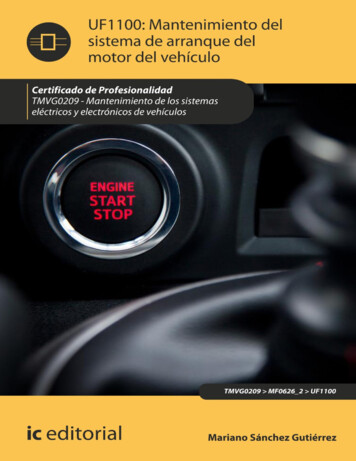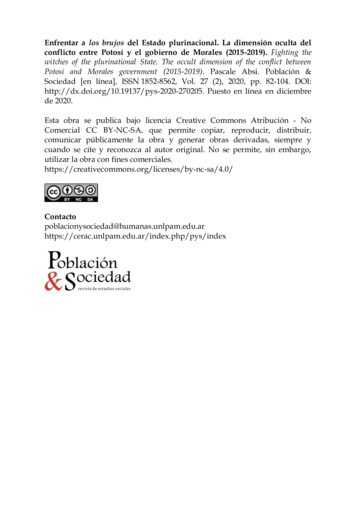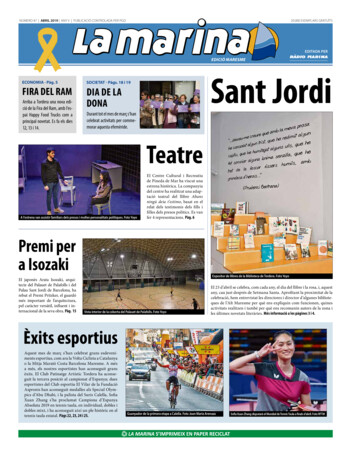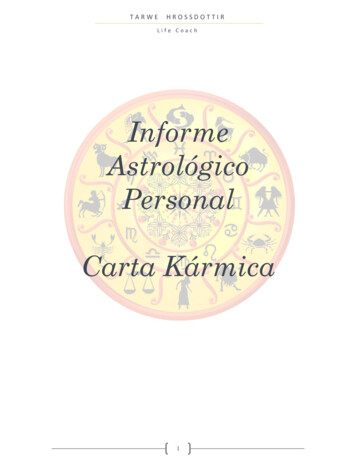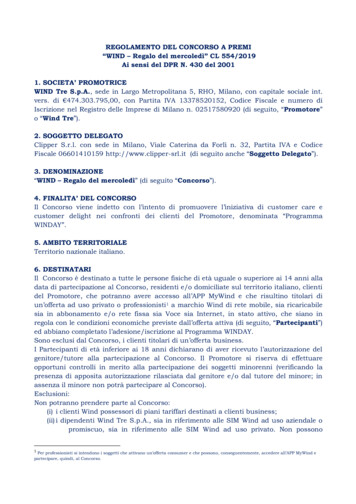
Transcription
Submitted on: February 6, 2013Biblioteca Digital del Patrimonio Iberoamericano: open source technologyin the service of a major cooperative project.José Luis Bueren Gómez-AceboHead of the Digital Library Area, National Library of Spain, Madrid, Spain.biblioteca.digital@bne.esElena Sánchez NogalesHead of the Digital Library Section, National Library of Spain, Madrid, Spain.biblioteca.digital@bne.esCopyright 2013 by José Luis Bueren Gómez-Acebo, Elena Sánchez Nogales. This work is madeavailable under the terms of the Creative Commons Attribution 3.0 Unported /Abstract:The Digital Library of Ibero-American Heritage was presented at the National Library of Spain inSeptember 2012. This new portal provides access to the digital collections of the Ibero-AmericanNational Libraries grouped in ABINIA. It currently provides access to the collections of six NationalLibraries: Brazil, Chile, Colombia, Panama, Portugal and Spain. In the near future new partners areexpected to incorporate to the project.The development, after some time of study, has been done under open standards, such as XML,Dublin Core or MARC. The technology of the search engine is the open source Lucene/SOLR and theplatform is based on Java and HTML.The portal is already the biggest repository to search Latin-American content and, over time, it couldturn into a complementary tool to the most important projects in digital cultural content: Europeanaand the Digital Public Library of America.This paper outlines the history of the Project in the context of a growing Ibero-American focus ondigital projects and access to cultural heritage, the current situation, the technological architectureand the impact within end users.Keywords: Digital libraries, Ibero-America, open source, international cooperation.1
1. FOREWORD: WHAT IS BDPI?The Digital Library of Ibero-American Heritage (BDPI) is a project started by theAssociation of National Libraries of Ibero-America (ABINIA) with the aim to create a portalthat would provide a single source from which to access the digital resources of all theparticipating libraries.The portal was made public during the XXIIIth Meeting of ABINIA, hosted by the NationalLibrary of Spain (BNE) in September 2012. The goal is to keep growing with theincorporation of as many libraries as possible and thus turning it into a reference site andreinforcing its presence in the web and networks of all the participants.The portal integrates the bibliographic descriptions of the digital objects hosted by thedifferent contributing libraries. An own tailor-made metadata model (similar to Dublin Core)has been adopted. Participant libraries submit metadata in the most standardized version theyare able to provide (mainly Dublin Core or MARC) and they are indexed in a server hostedby the BNE. Searches are performed in this server and the digital objects are viewed in theprovider library site. BDPI does not keep digital objects, only metadata. Both the content ofthe bibliographic descriptions and the management of the digital objects are responsibility ofthe different participating libraries.At the moment of writing this paper the available materials in BDPI were: Drawings, engravings, photographs:Books:Manuscripts:Cartographic material (printed and manuscript):Scores (printed and manuscript):Newspapers and magazines:Electronic resources:Sound recordings (musical and non-musical):Web sites:41,853 titles62,9668,0026,94321,6419,2328917,0336602
2. THE PROJECT: BACKGROUND AND HISTORYThe idea of creating BDPI dates back to 2009 when ABINIA agreed the creation of a portalthat provided a single access point to the digital collections of the Latin-American nationallibraries.A similar Project had been developed between ABINIA and UNESCO with the creation in2001 of the digital Library El Dorado. This project was extended until 2003 and its scope wasto make available digital works of the Latin-American national libraries, using the z39.50protocol. Since 2003 the situation around digitisation has significantly varied but it is fair tosay that today’s achievements are to a great extent the successful outcome of all thoseprevious efforts of cooperation and standardization.When the creation of BDPI was proposed back in 2009, the BNE, who had just started asystematic digitisation project and launched their new portal “Biblioteca Digital Hispánica”(BDH), offered to coordinate and lead the project.Initially, the BNE studied the adaptation of the National Libraries Global Prototypedeveloped by the National Library of New Zealand. The intention was to customize thatsoftware to the project needs. Such adaptation required the development of certainfunctionalities as well as some changes in the interface look and feel.In parallel to those development tasks, the BNE sent at the end of 2010 some forms to theLatin-American national libraries in order to gather information about the status of theirdigital libraries and their future integration in the portal.During 2011 the prototype was evaluated and the conclusion highlighted the value of somefunctionalities such as OAI-PMH protocol; records search and retrieval; popular records,collection management, facets to filter results; records translation, multilingualism However, as a consequence of working with a prototype, there were a number of technicalinconveniences: No possibility to choose in which index to search.Inexistence of an advanced search.Impossibility to order the results.Loss of some navigation elements.Only DC visualisation possible.These technical inconveniences were repairable but the project faced, furthermore, somestrategic problems. On one side, the prototype by that time was not in production in anyplace, on the other, the developing company gave no service in Spain so any developmentrequired a different company to take responsibility of the code and to start almost fromscratch.As a result of this evaluation, it was decided to discard the prototype and use instead thetechnology under which the Biblioteca Digital Hispánica (BDH) had been developed. It isimportant to take into account that when the BNE started to study the possibility ofdeveloping BDPI, the BDH had just been launched. By 2011 more than two years have3
passed and in the meantime the BNE’s portal had established and shown adaptability andstrength to support a big project.The development allows to incorporate all the functionalities foreseen in the prototype aswell as to adapt the interface to the designed look and feel. Furthermore it is possible toinclude in BDPI all the services implemented in BDH with no added costs. The developmentis Lucene/SOLR based and has been built on the specifications of the BNE so there’s greatcontrol of the adaptation and evolution possibilities.During 2012 different libraries were aggregated to the portal and the development and designworks ended. Finally, it was made public in September 2012, within the XXIII Meeting ofABINIA.3. MORE ABOUT BDPI: TECHNOLOGICAL INFRASTRUCTUREThe development of the BDPI portal is based on open-source standards, extensivelywidespread in the library domain, such as OAI-PMH and the SOLR search engine. Summingup, its main features are the following:Search engine: it is designed on the basis of the open-source technology Lucene / Solr. Thissearch engine indexes the content from all the sources providing data to BDPI. Queries aremade against this engine.Programming language: the BDPI search application is essentially a web app complyingwith J2EE standards. It is Java-based and displayed on an Apache Tomcat application server.All the pages in the search application are implemented in HTML format.Indexing process in the search engine: the source data (descriptive metadata) from theBDPI libraries are obtained either via OAI-PMH (whenever the option is available, being thepreferred way of data exchange) or a static XML file containing the descriptive metadata.Once these metadata from the different providers are captured, XSLT templates are applied toenable conversion and integration of the original metadata into the fields set-up within theSolr structure. This conversion process generates IDX files, which are new XML files in theformat accepted by Solr to perform the indexing process, which will eventually feed thesearch engine.Servers hosting BDPI:BDPI search components are hosted in two servers: One of them hosts the search engine (Solr). Features of this server: 540 GB Capacity. 4 processors Intel (R) Xeon (R) CPU E5450 3.00GHz 12 GB RAM. A second server hosts the search web application, together with all the indexingprocesses (XSLT conversion files and indexing scripts) and the database (containingMYSQL tables to keep track of statistics about the application usage). Main server4
features: 247 GB Capacity. 2 processors Intel (R) Xeon (R) CPU E5540 2.53GHz 4 GB RAMOAI-PMH protocol:The preferred way of data exchange is metadata harvesting via OAI-PMH. However, some ofthe participant libraries were not able to make records available through OAI, and datasubmission was completed with alternative means such as sending a physical storage unit orby email.The data sources for each participant library are so far: National Library of Spain: via OAI-PMH and based on Marc21 I-PUB?verb ListRecords&set bne01&metadataPrefix marc21 Newspaper collection of the National Library of Spain: via OAI-PMH, in DublinCore-Extended format:http://hemerotecadigital.bne.es/oai.vm?verb ListRecords&metadataPrefix dc ext National Library of Portugal: via OAI-PMH, in Marcxchange (UNIMARC) format:http://oai.bn.pt/servlet/OAIHandler?verb ListRecords&set bndlivre&metadataPrefix marcxchange National Library of Brazil: records were submitted in a static XML containingmetadata (Dublin Core-based format) corresponding to the library’s digital resources. National Library of Colombia: via OAI-PMHm in Dublin Core open archive.php?verb ListRecords&metadataPrefix oai dc National Library of Chile: records were submitted in a static XML containingmetadata (Dublin Core-based) corresponding to the library’s digital resources. National Library of Panama: via static XML, Dublin Core-based.API for external search1: One of the milestones in the development of BDPI was thelaunching of a web service which allows launching queries directly from external searchinterfaces. Similarly to the Europeana API, the aim is to attract visitors from other services,which in return also increase and enhance the functionalities offered to their users.OCR: It should be mentioned that the portal allows full-text searches for those records withsuch data included in their descriptive content.11Technical information about the BDPI API is available I.pdf5
4. BUILDING BDPI: METADATA AND INGESTION PROCESSOnce data have been submitted by the provider or harvested via OAI, the process ofconversion and integration in BDPI portal takes place.The first phase of this process implies a thorough and in-depth analysis of the metadataprovided: amount and quality of data, fields or format descriptive elements used, identifiers,categorization of structural content such as type of material, and actual access to the digitalobjects. The aim is to extract the highest amount of information, while homogenizing andclustering data together as much as possible.In connection with this, an important aspect in the development of the entire project, withheavy implications beyond metadata readiness, comes from the wide range of technologicaldevelopment levels among the participating libraries. While some libraries are in a position tooffer and share tens of thousands of digital objects, structured and standards-compliantmetadata, and long implemented communication protocols, others are still at an early stage ofthe process, and have a small part of their collection digitally available, with descriptions notfully subject to cataloguing standards and protocols such as OAI-PMH not in place yet.The BNE has undertaken an exhaustive analysis of data received in order to ensure thatindexing becomes as accurate as possible. Data was received in the following models: BNE: MARC21BNP: UNIMARCBNB: Dublin CoreChile: Dublin CoreColombia: Dublin CoreRecords are indexed according to a data schema which is quite straightforward but essentiallyallows searching and retrieving information from the basic data fields, to help describe,identify and discover the eSubject(s)EditionIdentifierResource typePIDDescriptionRelated informationThumbnailInstitution/ProviderObviously, a higher complexity and density in the level of bibliographic description means amore complex mapping, along with an eventually better identified and retrievable resource.Such was, for instance, the case of Portugal.6
Special efforts had to be deployed specifically for the fields of Date, Type of resource andSubject, which were heterogeneously formatted and particularly sensitive as long as they areoffered and presented as facets that had to keep a unified format, to enable users to filterwithin a cohesive categorization. The case of Brazil furthermore posed duplication problems,as subjects were given both in Portuguese and English, with no possibility of automaticsorting from the xml. This forced to manually carry out the equivalence and matchingbetween Portuguese/English subjects, in order to present as facets only one of the twoversions (Portuguese).Other important tasks in the metadata analysis and mapping were: definition of the element which would in each case work as ID for theresource; selection and presentation of the thumbnail (specifically included in themetadata in the cases of Spain and Portugal; obtained through an automatedprocess which extracts the image from the .pdf – and whenever a .pdf is notavailable, the library logo), identification and validation of the URL giving access to the actual resource,be it directly to the digital object (preferred) or to the description of the digitalresource from where a link is offered to the object. The latter was the case ofChile - who requested links to be directed to their Memoria Chilena portal and Portugal, where rights issue might arise from the fact that in some casestwo versions (public and internal) of the digital object are offered.5. SHOWCASING BDPI: INTERFACE, COLLECTIONS AND FUNCTIONALITIESFunctionalities offered in BDPI portal intend, on one side, to facilitate information search andretrieval and, on the other, to provide users with tools that ease navigation in case they don’thave specific information needs.In order to reach this goal, BDPI’s portal counts on the following functionalities: Simple search allows you to search all record fields quickly and intuitively. Bydefault, the search is restricted to specific bibliographic record fields from thecatalogue (namely title, author, subject, description or all of these). Furthermore it ispossible to select in which index the search should be done. Finally, it is possible toindicate whether the query should be executed in the full text (OCR) field or not. An advanced search enables you to search in more than one field at a time, indicatingwhich indexes should be used to restrict the search results. In addition to the optionsalready included in the simple search, the query can be done on these other fields:"Place of publication", "Publication data", "Date" of publication, “ISBN/ISSN”, “Callnumber”, “Universal Decimal Classification (CDU)” and “Geographic location”.It is also possible to set limits or filters to the search under the following criteria:Institution, Type of document and Language.Viewing the results7
If the search retrieves more than one result, a list with abbreviated information(thumbnail, title, and author) will be displayed identifying the records obtained. Bydefault, the records are sorted according to relevance criteria calculated internally bythe BDPI search engine. The order can be changed using a dropdown menu; thepossible order options are title, author and date. Detailed view shows as much information as possible and available about the worksdescribed.FacetsIn order to facilitate the results exploration some faceted fields allow refining and limitingnavigation. It is possible to filter by Institution, Subject and Type of document.CollectionsThe collections offer the user additional means of accessing documents, grouped into crosslinked collections based on common characteristics relating to the type of document, theme,or their particular relevance, interest, appeal or importance within the documents contained inBDPI. They are meant to be an inviting and attractive way of discovering some of the usually‘hidden’ treasures of our heritage.From the navigation bar on the homepage it is already possible to access the collections ofManuscripts; Pictures, engravings and photographs; and Maps. Furthermore there is a"Collections" page with more featured collections and suggestions for accessing common orrelevant content from all the collections in the BDPI. At the time the portal was launched,these were: Geography and travel, Music, Music scores and Literature and literary studies.More collections recently incorporated were Magazines and press and Tales and legends.8
6. EVALUATING IMPACT AND USE OF BDPIUsage of the portal since it was launched has been constant and stable with around 400 usersper day. Although it is true that Spain encompasses 40% of access, it is interesting to observehigh interest in the portal coming from Brazil (13%), México (7%), Colombia, Panamá,Argentina (5% each); Chile, EE.UU., Portugal y France (2-3%).The study of the statistics data (gathered through Google Analytics) confirms (although thisanalysis has not been done in depth) that there are two main user profiles for BDPI, differentand complementary: on one hand, those who approach BDPI as a research source where theycan widen their information search; on the other, those who reach BDPI thanks to some news,recommendation or one-time event (a new collection, for example). This conclusion isreached from the fact that traffic sources are, firstly Facebook and on the third place BNE’sBiblioteca Digital HispánicaConsidering Facebook own features and nature, it is not surprising to see that access from thischannel gets concentrated on specific periods, particularly on the first days after the portallaunching and dissemination within social networks, and also following the publication ofnews or highlighted collections, directing users to the portal. The average duration of thesevisits is 03:32, slightly below the overall average duration of visits from all sources.The other important traffic source for BDPI is Biblioteca Digital Hispánica (the digital libraryof the BNE), since November 2012. The reason behind is the integration in this portal of anAPI which displays, once a query is made in BDH, the results obtained from the same queryin BDPI, which can be then accessed to directly only by clicking on the API link. It is veryinteresting to note that visits coming from this source often double (or even triple) theaverage numbers in terms of time spent and pages seen in BDPI. And these numbers let usthink that the API does indeed widen the functionalities and services offered by BibliotecaDigital Hispánica, and as such the API tool is proved to be appreciated and used among ourusers.The same goes for the Europeana API, also integrated in BDH and offering the same serviceas a gateway to this pan-European important resource.We can therefore see these two different ways of accessing the content as being both relevantand complementary: Facebook, on one side, providing a high number of one-off visits, as aresult of some outstanding content or particular news; BDH’s API, on the other, as a muchmore sophisticated tool used by more specialized users.These facts lead to the conclusion that BDPI has a great potential to provide services to,summarising, the two main kind of users that a library (national, particularly) can have:general citizens attracted by curiosity or recommendation; and specialists who find here asingle and relevant access point that enhances the results of their research.Dissemination through social networks and the API implementation seem key actions toincrease the visibility of the portal. One more way to achieve this objective could be trying toplace it in web pages, blogs, educational forums, etc. in which people look for this kind orresources. The second traffic source to BDPI is a Brazilian2 web page dedicated to informabout cultural activities and, among them, sites to access digital content.2catracalivre.folha.uol.com.br9
Overall figures along the first seven months: Unique visitors: 63.222.Visits: 80.714.Page views: 374.101.Average visit time: 03:42.New visits rate: 78,21%Pages per visit: 4,63.Rebound rate: 59,22%5. ENVISAGING BDPI: THE FUTUREQuoting a very famous Spanish poem, “the path is made by walking”. And the way we havealready went over the recent years brings closer and closer the old dream (and apologize herefor the commonplace) of a true global digital library.Projects like Europeana (2008) and the DPLA (2013) make it real to be able to access, fromone single search, the digital content of thousand of European and North American culturalinstitutions.It may seem presumptuous to talk about BDPI in connection with Europeana and the DPLA.The level of awareness, the amount of content and the budget it manages is not comparable tothe other two projects. However, BDPI is indeed similar in its philosophy and objectives.Offering a single access point to digital collections in Latin-American libraries is, savingquantitative distances, the same that is offered in Europeana and DPLA. No matter thesedistances, there is no technical or strategic obstacle that prevents BDPI from being the seed ofa global project to access Latin-American content.Latin-American countries share, as well as the European and North American, history,culture and languages. The presence of their collections under the same context enriches theparticular collections of the participating institutions.The discovery of the New World (at least from the perspective of the Spaniards who reachedthe Caribbean coasts), the impact of the European presence in the American continent, wars,evangelization, slavery, independency process, literature, indigenous languages there is amultiplicity of themes in which the Latin-American perspectives enrich the informationavailable in the different institutions.BDPI is now a solid project with the participation of important libraries, and provides accessto around 170.000 works. The reception among users is being very positive and so far it hashad an excellent behaviour from a technical point of view.It is possible to set two concrete objectives that should be possible to reach in the short andmedium term.10
Incorporating as many libraries as possible to the portal: the first step toconsolidate the project should be the effective incorporation of all the librariesincluded in ABINIA. Afterwards, the possibility of offering other big libraries andother cultural institutions the opportunity to aggregate their collections to theportal should be considered. Increase the portal’s visibility: Usage statistics since BDPI’s launch show that itis interesting for those users who get to know it. However, until now, no bigefforts have been done to improve the awareness of the portal among citizens. Toreach this goal it is key to count on the cooperation of participating libraries, whomay - through their social networks, or with the API implementation - contributeto disseminate the project in their respective countries. Enriching the portal with blogs, creating an specific Facebook profile, cooperatewith Latin-American studies Institutes (or cultural in general), create a distributionlist, enhance the portal services with specific tools for the different kind of users,the creation of curated content are actions that will also contribute to improvethe portals visibility.Moreover these operational objectives it has to be mentioned that BDPI doesn’t have untilnow a real organizational model. It is necessary to agree and establish the way in which it isgoing to be managed throughout time and to clarify key aspects such as: Operational responsibilities.Staff dedicated to the project.Funding.Participation requirements.The creation of BDPI is, so far, the history of a success. No Latin-American cooperativeproject had ever joined the amount of data and had had a comparable utilization level. In thissense, it is remarkable how technology, particularly the use of standards and open sourcetools, facilitate the fulfilment of these projects.The mere existence of this portal should contribute to foster digitization, standardization andopen technologies use. Moreover its political significance, BDPI’s success will confirmcultural policy makers the importance that digitization and digital information has forcitizens. Free access to quality cultural content promotes education, research and leisure.Latin-America as a cultural reality deserves a self space in the universe of cultural institutionsand BDPI is an excellent example of how cooperation in this field is viable and has a verypositive impact.11
The portal integrates the bibliographic descriptions of the digital objects hosted by the different contributing libraries. An own tailor-made metadata model (similar to Dublin Core) . It is Java-based and displayed on an Apache Tomcat application server. . others are still at an early stage of the process, and have a small part of their .
